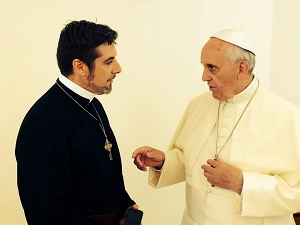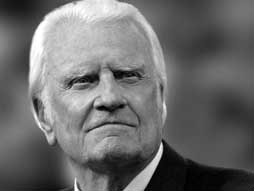The World is now Mister Rogers’ Neighborhood.
The daily educational program for children debuted on PBS in 1968, after two smaller runs – in 1961 with Misterogers on the CBC, and in 1966 with Mister Rogers’ Neighborhood on the Boston-based Eastern Educational Network, a forerunner to the Public Broadcasting Service. Every day, Fred Rogers would get home from work, put on a cardigan and sneakers, and talk to his neighbours, delivering lessons on friendship, love, kindness, acceptance, and more. Viewers were an important part of the neighborhood, too. Now, the world is a great social laboratory for putting the ideas and values of Fred Rogers into everyday practice in a time of life and death – a time of the continuous present, without past or future.
As the world hits bottom – which may paradoxically be when it hits the peak for COVID-19 cases, which in the United States, now the world epicentre of the coronavirus pandemic, may come in about two weeks time in mid-April – there will be, and already are around the world, early signs of recovery of a better us, and of a better world.
It is still both late days and early days simultaneously, but the 85-year-old argot of personal recovery can be applied now to public recovery, as well, I think: “One day at a time” and “just for today” should no longer be thought of as just private lifesaving advice for recovering alcoholics and addicts, but a public signpost for all for the rebuilding task that will be ahead, one person and one community at a time. The 12-step movement, dates back to June 1935, when Bill Wilson, a failed New York City stockbroker, and Dr. Bob Smith, an Akron, Ohio physician, both recently or newly sober (particularly Dr. Bob, although Bill W. wasn’t that many months ahead of him on the sobriety curve) became friends and Alcoholics Anonymous (AA) was born in Ohio. Both sayings, “one day at a time” and “just for today” are used interchangeably as both verbal slogans and written mottoes, the former coming from AA, and the latter, also a prayer to some, and a poem to others, from Narcotics Anonymous (NA), formed in 1953. They have proved useful as something pithy and easily grasped by the still-suffering in the early days of recovery, grasping for something tangible to hang onto for just one more second, minute, hour or day, grasping for those words every bit as much as a drowning person grasps for the rung on the ladder or life preserver.
Which is probably as good a description as any of the COVID-19 world we live in today, with a March that has birthed a dread spring in a month that seemingly never ends, where waking up every morning in March 2020 has been like having the voice of Capt. Jean-Luc Picard as a personal alarm clock inside my head, uttering such classic Star Trek lines as “damage report’ and “Red alert. All hands stand to battle stations” (https://www.youtube.com/watch?v=wV30YwXaKJg&feature=share&fbclid=IwAR1c8IoTcgboKQu3u12DNJ_rRNzvH6k0ZNDK3p3b3KLEGBIZLJ4ktx6XBMI).
Fortunately, Gene Roddenberry has been a reminder to me since 1966 that character, courage and goodness are not proprietary virtues of the religious, non-religious, believers or non-believers. We all can and do share in them. And we’re going to need those virtues, and all of us, believers and non-believers, in the days ahead. In this month of unbelievable sounds and images, where the next day’s sounds and images routinely exceeds the horror and scale of the previous day, two stand out for me, one very well known, the other not so much. The first is the image of the floating hospital United States Navy Ship (USNS) Comfort as it entered New York Harbor March 30 during the Biological Armageddon coronavirus pandemic response in New York City. Mike Segar’s photograph for Reuters illustrates why it is often said “a picture is worth a thousand words.”
Ordered to “lean forward,” a military term familiar to those who serve in the United States Navy, meaning the willingness to be aggressive, to take risks, the USNS Comfort (T-AH-20), homeported at Naval Station Norfolk, Virginia, sailed from port up the Atlantic seaboard Saturday. What those sailors, military doctors and nurses, officers, enlisted personnel and civilians aboard the Comfort must have been thinking as they answered the call of duty and sailed north into a Biological Armageddon. The Comfort will provide relief for New York hospitals by taking on non-COVID-19 cases and allowing the hospitals to focus on the most critical patients suffering from the virus.

The second that stands out for me is a brief audio clip I heard on Twitter March 24, the day after the “surge” hit New York City. Tim Mak is National Public Radio (NPR’s) Washington investigative correspondent – and an emergency medical technician (EMT), which is how he got the message. It is the most chilling on the pandemic I have heard to date. I think that’s because of both the subject matter, but also because there is something eerie about that electronically-generated voice on the automated message that went out:
“This an emergency message. This is a priority request for D.C. MRC volunteers (District of Columbia (DC) Medical Reserve Corps (DC MRC)…” (https://twitter.com/i/status/1241471610395267084)
The automated message went out March 21 to health care professionals in Washington, D.C.
The District of Columbia (DC) Medical Reserve Corps (DC MRC) supports the DC Department of Health (DC Health) in its role as lead for public health and medical emergency preparedness, response and recovery by recruiting, training, and deploying medical and non-medical volunteers to assist with planned events and emergencies.
Roddenberry, a Southern Baptist-turned humanist, held and spoke a truth held and spoken by another Southern Baptist, the Rev. Martin Luther King Jr., and others before him: the universe unfolds as it indeed should, and the arc of the moral universe is long, but it bends toward justice. A perfect illustration of this is “Lower Decks,” the 167th episode of the series and the 15th episode of the seventh and final season, which originally aired on Feb. 7, 1994. With remarkable simplicity and brevity, these five sentences from Picard are offered in a ship-wide address from the captain’s ready room off the bridge when Ensign Sito Jaxa, a Bajoran Starfleet officer serving aboard the USS Enterprise, is killed on a covert mission in the line of duty (https://soundingsjohnbarker.wordpress.com/2018/09/24/church-of-star-trek-the-next-generation-and-the-moral-arc-of-the-universe/):
“‘To all Starfleet personnel, this is the Captain. It is my sad duty to inform you that a member of the crew, Ensign Sito Jaxa, has been lost in the line of duty. She was the finest example of a Starfleet officer, and a young woman of remarkable courage and strength of character. Her loss will be deeply felt by all who knew her. Picard out’.” (https://www.youtube.com/watch?v=40XUt1HU5H8&feature=share)
Writing a decade after Bobby Kennedy’s assassination in his 1978 book, Robert Kennedy and His Times, the American historian, Arthur M. Schlesinger, commenting in the foreword, said Kennedy “possessed to an exceptional degree what T. S. Eliot called an ‘experiencing nature.’ History changed him, and, had time permitted, he might have changed history. His relationship to his age makes him, I believe, a ‘representative man’ in Emerson’s phrase – one who embodies the consciousness of an epoch, who perceives things in fresh lights and new connections, who exhibits unsuspected possibilities of purpose and action to his contemporaries.”
Such men and women arise from unexpected and unlikely places.
Abraham Lincoln, who in a speech delivered on June 17, 1858, at the close of the Republican state convention at the Illinois State Capitol in Springfield, reaching back to the first century and the words of the Apostle Saint Mark the Evangelist (“And if a house be divided against itself, that house cannot stand”) gave what would become one of the most famous speeches in American history.
Said Lincoln on that late spring day: “A house divided against itself cannot stand. I believe this government cannot endure permanently half slave and half free … It will become all one thing, or all the other.”
Five years later, he gave the most famous speech in American history. Republican President Abraham Lincoln’s 273-word “Gettysburg Address,” lasted less than two minutes, and was delivered at Gettysburg, Pennsylvania on Nov. 19, 1863. Edward Everett, the former senator and secretary of state – and brilliant Massachusetts orator – who, without notes for two hours, preceded President Lincoln in speaking at Gettysburg, gave a brilliant speech that day, as expected, but Lincoln happened to follow with what we now remember as the “Gettysburg Address.” Lincoln’s speech immediately struck a chord and remains the best-known speech in American history more than 150 years after it was given. Everett wrote a letter to Lincoln the day after their speeches, saying, “I should be glad, if I could flatter myself that I came as near to the central idea of the occasion, in two hours, as you did in two minutes.”
Said Lincoln that long-ago November day: “Four score and seven years ago our fathers brought forth on this continent, a new nation, conceived in Liberty, and dedicated to the proposition that all men are created equal.
“Now we are engaged in a great civil war, testing whether that nation, or any nation so conceived and so dedicated, can long endure. We are met on a great battle-field of that war. We have come to dedicate a portion of that field, as a final resting place for those who here gave their lives that that nation might live. It is altogether fitting and proper that we should do this.
“But, in a larger sense, we can not dedicate – we can not consecrate – we can not hallow — this ground. The brave men, living and dead, who struggled here, have consecrated it, far above our poor power to add or detract. The world will little note, nor long remember what we say here, but it can never forget what they did here. It is for us the living, rather, to be dedicated here to the unfinished work which they who fought here have thus far so nobly advanced. It is rather for us to be here dedicated to the great task remaining before us – that from these honored dead we take increased devotion to that cause for which they gave the last full measure of devotion – that we here highly resolve that these dead shall not have died in vain – that this nation, under God, shall have a new birth of freedom – and that government of the people, by the people, for the people, shall not perish from the earth.” (https://www.youtube.com/watch?v=U2a-S3rjDBw&feature=share&fbclid=IwAR1LKNwMramCkVoodunLwy1SGqQFCBsejS5cLU9Q0TgVYPPPGs7pFUBxdJw)
I wrote about AIDS in the 1980s. And I remember the climate of fear in 1986 that reporters were not untouched by when we were assigned stories that meant going inside provincial reformatories and federal penitentiaries to interview HIV-positive prisoners in Ontario. The high callings of journalism are to speak truth to power, as well as comfort the afflicted and afflict the comfortable. But exactly how AIDS was transmitted in terms of morbidity and mortality was not completely understood 35 years ago. So I watched with surprise and unexpected admiration as C. Everett Koop, an evangelical Christian, who served as surgeon general under U.S. Republican president Ronald Reagan from 1982 to 1989, and was well known for wearing his uniform as a vice admiral of the United States Public Health Service Commissioned Corps, had the singular political courage to speak the truth about the science of AIDS as our knowledge increased. According to the Washington Post, “Koop was the only surgeon general to become a household name” (https://soundingsjohnbarker.wordpress.com/2015/01/15/empathy-and-compassion-are-the-gifts-of-our-shared-human-experience/).
Former U.S. president Bill Clinton, a Democrat, also got it right in his first inaugural address Jan. 20, 1993 when he said, ”by the words we speak and the faces we show the world, we force the spring … we recognize a simple but powerful truth – we need each other. And we must care for one another.” He went on to say, we are “tempered by the knowledge that, but for fate, we – the fortunate and the unfortunate – might have been each other.”
Guardian columnist George Monbiot argued yesterday that power has “migrated not just from private money to the state, but from both market and state to another place altogether: the commons. All over the world, communities have mobilized where governments have failed.”
Joanne Rogers is 92 and the widow of Fred Rogers. She has been getting a lot of telephone calls at her apartment in Pittsburgh, says Los Angeles Times staff writer Amy Kaufman in a March 29 story wondering what Mister Rogers, who died in 2005 at the age of 74, would say and do to cope with the COVID-19 coronavirus pandemic?
“When Fred was a boy and scary things would happen to him, his mother used to tell him: ‘Freddy, look for the helpers.’ So he would have talked about the helpers,” Joanne said.
“Helpers,” she explained, are those individuals who – even at the height of global chaos – try to find a way to ease the burden for others; folks such as doctors, nurses, grocery store cashiers, and mail carriers.
You can also follow me on Twitter at: https://twitter.com/jwbarker22
















